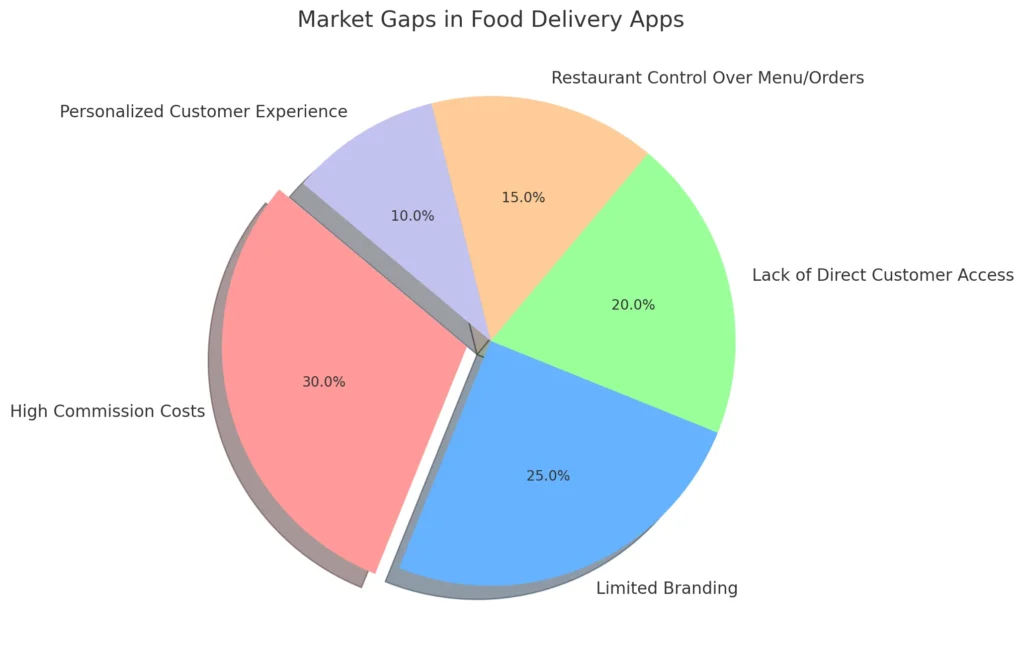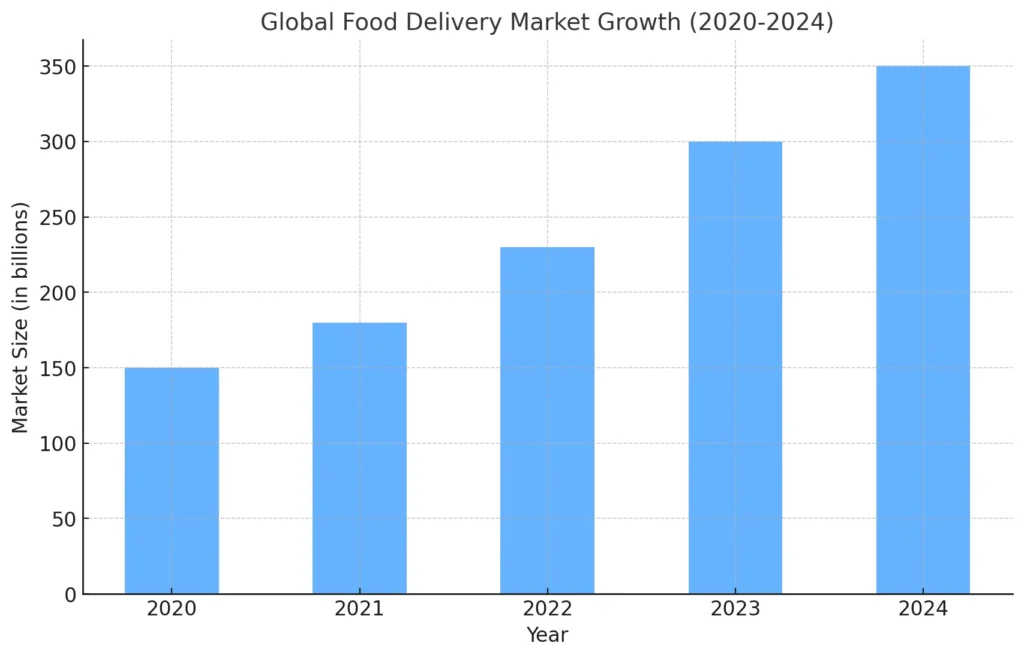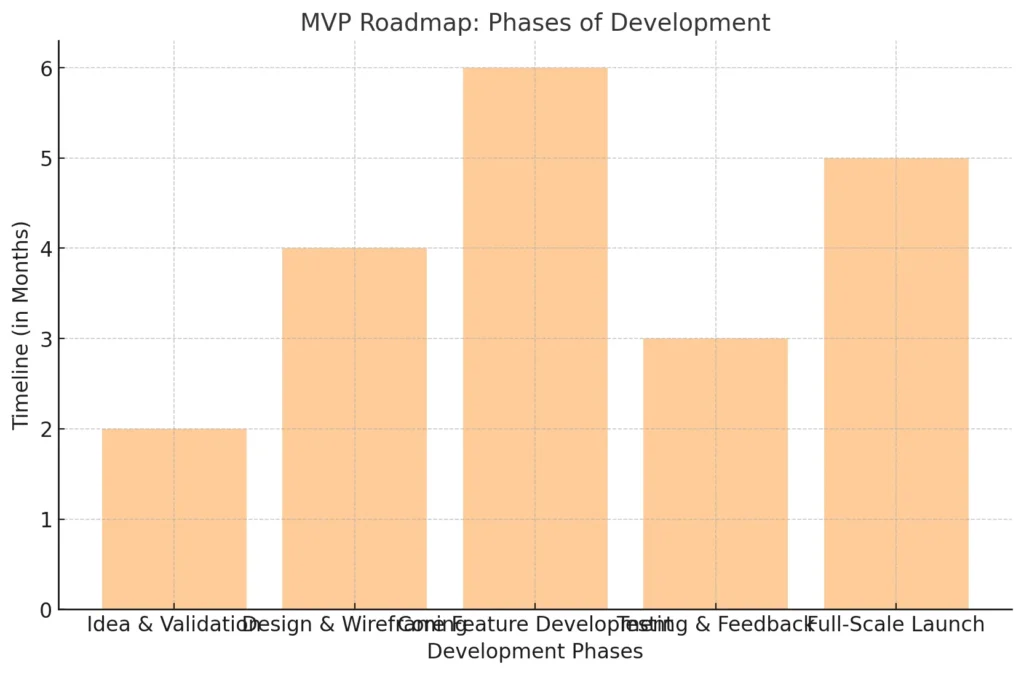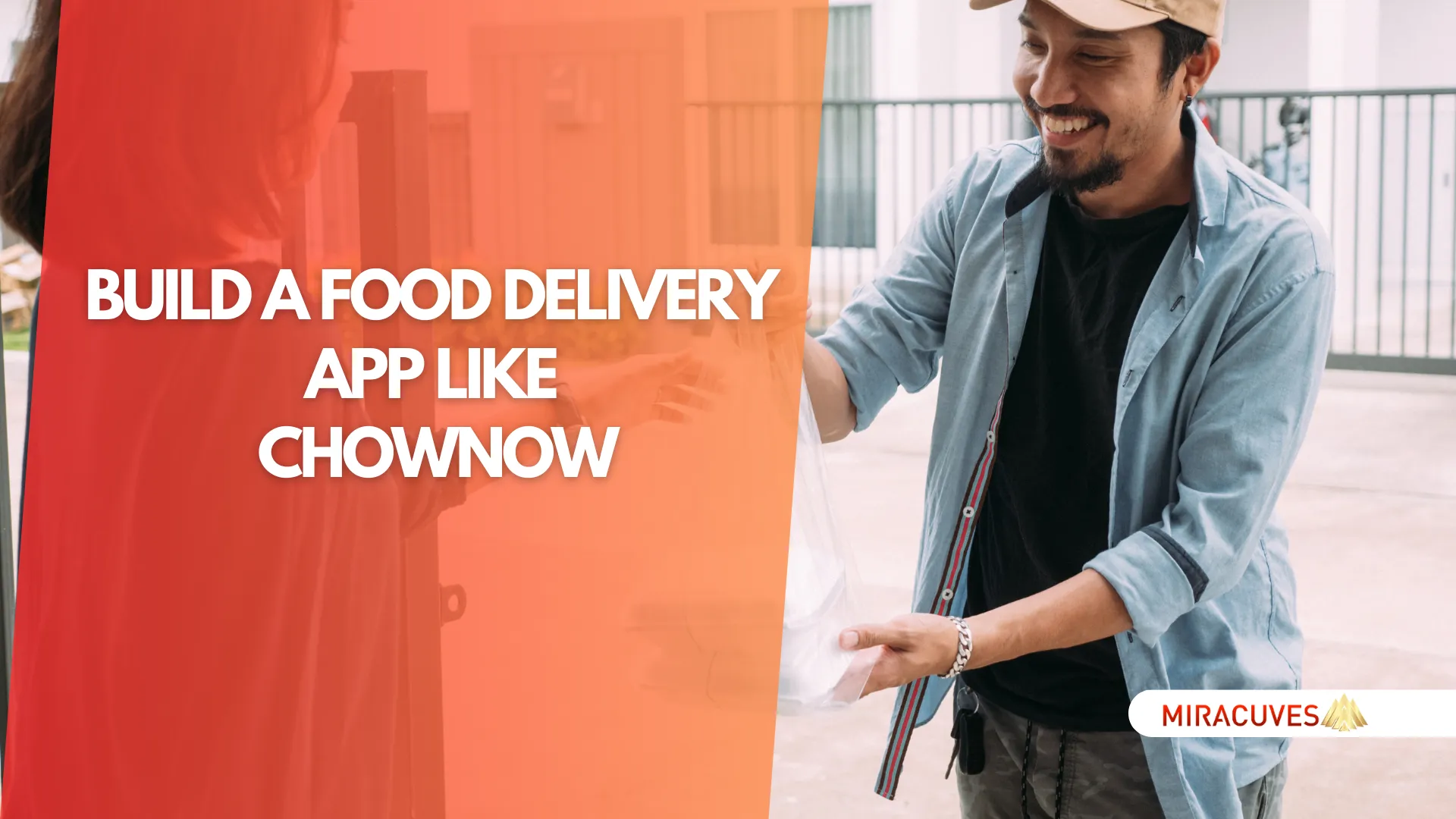In today’s fast-paced digital world, the demand for food delivery services has skyrocketed, and apps like ChowNow have emerged as game-changers for local restaurants. ChowNow stands out by offering restaurants a commission-free platform, allowing them to take control of their online orders without losing profits to third-party apps. As a restaurant owner or entrepreneur, building a custom food delivery app like ChowNow can give you full control over your brand, customer relationships, and revenue.
Unlike traditional food delivery platforms that charge hefty commissions, ChowNow’s business model empowers restaurants by giving them direct access to their customers. This makes it an attractive option for restaurants seeking independence from major players like UberEats or DoorDash. By developing an app similar to ChowNow, you can tap into this market trend, offering restaurants an alternative to the traditional commission-based platforms while providing customers a seamless ordering experience.
Whether you’re aiming to support local restaurants, build a niche delivery service, or simply explore the growing food tech industry, creating a ChowNow-like app presents a lucrative opportunity. In this guide, we’ll explore the business model, key features, and costs involved in building a food delivery app like ChowNow, along with insights on how you can bring your vision to life with the help of Miracuves Solutions, a trusted leader in app development.
What is ChowNow and What Does It Do?
ChowNow is a revolutionary food delivery and ordering platform that enables restaurants to take control of their online orders, free from the commission-heavy structures imposed by many third-party services. Unlike giants like UberEats or DoorDash, ChowNow focuses on empowering local restaurants by providing them with the tools they need to manage their own delivery and pickup services without sacrificing profits to third-party platforms.
At its core, ChowNow allows restaurants to create a custom-branded experience for their customers. Through the app, restaurants can offer a seamless online ordering system, handle deliveries or pickups, and maintain direct customer interactions. This is particularly valuable for smaller, independent eateries that often struggle to compete in an environment dominated by high-fee platforms. ChowNow charges restaurants a flat monthly fee instead of taking a cut from each order, making it an attractive choice for those looking to boost their profitability and build stronger customer relationships.
The app’s no-commission model has become a critical selling point in a market where margins are thin, and restaurants are seeking more control over their business operations. Restaurants using ChowNow can directly integrate online ordering into their websites and social media platforms, making it easier for customers to order without using third-party apps. This creates a win-win situation, where customers receive a more personalized experience, and restaurants retain more of their hard-earned revenue.
Why Build an App Like ChowNow?
The rise of commission-free food delivery platforms like ChowNow is reshaping the restaurant industry. Traditional food delivery apps charge restaurants significant commissions, sometimes up to 30% of each order, which cuts deeply into their profits. For many small and medium-sized restaurants, these fees are unsustainable. That’s why more restaurant owners are turning to platforms like ChowNow, which offer a cost-effective and sustainable solution.
By building an app similar to ChowNow, you give restaurants the power to manage their own online ordering systems, providing direct access to their customers without middlemen. This enables them to set their own pricing, control their branding, and manage customer data—essential elements for long-term business growth. Additionally, this model appeals to restaurants that want to offer delivery without relying on third-party platforms that often prioritize their own branding over the restaurant’s.
The benefits extend to customers as well. With a dedicated app for a specific restaurant or group of restaurants, the customer experience becomes more streamlined and personalized. They can order directly from the restaurant’s branded app, knowing that their favorite local spot is receiving the full profit from their order. In an increasingly competitive market, giving restaurants this kind of control and flexibility can be a major differentiator for your app.
By tapping into this growing demand for commission-free platforms, your app can carve out a niche that meets the needs of both restaurants and customers. This model isn’t just a passing trend—it’s the future of local dining, where restaurants regain control of their operations and build direct, lasting relationships with their customers.
How to Differentiate Your App from Competitors

The food delivery market is highly competitive, with major players like UberEats, DoorDash, and GrubHub dominating the scene. So, if you’re building a ChowNow-like app, it’s essential to differentiate your platform to stand out from the crowd. Offering unique selling points (USPs) will not only attract restaurants but also ensure customer loyalty.
One way to make your app stand out is by focusing on niche markets. For example, targeting eco-conscious consumers by offering sustainable packaging options or partnering with local, organic restaurants can give your app a unique edge. Another option is to focus on hyper-local markets, allowing users to support small businesses in their immediate area. This localized approach can foster a sense of community and loyalty.
Additionally, your app can provide advanced customization options for restaurants. Offering more control over menu design, promotional campaigns, and customer loyalty programs can set your platform apart. Features like multi-channel ordering (through social media, website, or app) and integrated delivery tracking can also be major differentiators.
Furthermore, excellent customer support for both restaurants and end-users can be a defining feature. Many of the larger platforms fall short in offering quick and personalized support, and focusing on this can improve user experience. You can also introduce advanced analytics for restaurants, helping them better understand customer behavior and improve their services.
By identifying and incorporating these unique elements, your app can rise above the competition and become a go-to solution for restaurants seeking independence from high-commission platforms.
Market Size, Growth, and Business Model

The global food delivery market has experienced significant growth in recent years, driven by changing consumer preferences, digital adoption, and the convenience of online ordering. As of today, the market is estimated to reach billions of dollars annually, with strong year-over-year growth. With more restaurants realizing the benefits of owning their delivery and ordering systems, platforms like ChowNow are well-positioned to capitalize on this trend.
ChowNow’s business model is particularly attractive for restaurants because it avoids the high commission fees charged by most major delivery platforms. Instead, ChowNow charges restaurants a flat monthly fee for using the platform, allowing them to keep more of their profits. This model is gaining popularity, especially among small and medium-sized restaurants that want more control over their margins and branding.
For entrepreneurs looking to build a ChowNow-like app, this presents an opportunity to tap into a rapidly growing market by offering an affordable, commission-free alternative to the major players. By providing restaurants with a flat-fee model, your app can attract restaurant owners who are tired of losing a significant percentage of their revenue to third-party platforms.
Additionally, the food delivery market is expected to continue expanding, especially with the growing adoption of mobile apps and online ordering. Customers increasingly prefer direct, user-friendly experiences that allow them to order from their favorite restaurants without the hassle of going through multiple platforms. This shift presents an ideal opportunity for new apps that cater specifically to restaurant owners and their direct customers.
Key Features of a ChowNow-Like App
| Feature | ChowNow-Like App | UberEats | DoorDash |
|---|---|---|---|
| Commission Model | No commission, flat fee or subscription | High commission (up to 30%) | High commission (up to 30%) |
| Custom Branding for Restaurants | Yes, full customization | Limited customization | Limited customization |
| Restaurant Dashboard | Comprehensive order and menu management | Limited, basic management tools | Limited, basic management tools |
| Multi-Platform Accessibility | Web, Android, iOS | Web, Android, iOS | Web, Android, iOS |
| Payment Integration | Multiple options (credit cards, digital wallets) | Credit cards, PayPal | Credit cards, PayPal |
| Order Tracking and Notifications | Real-time tracking with notifications | Real-time tracking | Real-time tracking |
| Restaurant Control Over Menu | Full control | Limited to platform policies | Limited to platform policies |
| Customer Relationship | Direct customer relationship | Indirect (via platform) | Indirect (via platform) |
When building a food delivery app like ChowNow, the core features you include are crucial to its success. ChowNow focuses on empowering restaurants by offering a set of powerful tools that allow them to manage their own delivery and takeout services. To create a competitive app, you’ll need to integrate features that not only provide value to restaurants but also enhance the customer experience.
Restaurant Management Dashboard
Your app should offer restaurants a comprehensive dashboard where they can easily manage orders, update menus, and track deliveries. This feature allows restaurant owners to have full control over their operations without relying on third-party platforms. They can also view analytics, helping them make data-driven decisions on promotions and menu changes.
Custom-Branded Ordering System
One of the standout features of ChowNow is that it allows restaurants to offer a custom-branded online ordering experience. Your app should enable restaurants to integrate their branding into the platform, so their customers can place orders directly from their website or mobile app. This strengthens the restaurant’s identity and builds customer loyalty.
Commission-Free Pricing Model
To attract restaurants, a commission-free model is essential. By offering a flat fee or subscription service, restaurants can avoid the high commissions that other platforms charge. This not only saves them money but also helps create a long-term partnership with your app.
Multi-Platform Accessibility
The app should be accessible across multiple platforms, including web, Android, and iOS, to reach a wider audience. This allows customers to order from any device, and it provides restaurants with greater flexibility in how they manage their operations.
Seamless Payment Integration
A secure and seamless payment system is vital. Support for multiple payment options such as credit cards, digital wallets, and even direct bank transfers will give customers the convenience they expect. Integrating reliable payment gateways will ensure smooth transactions.
Order Tracking and Notifications
For an enhanced customer experience, real-time order tracking and automated notifications are essential. Customers should be able to see their order status and receive updates about delivery times.
Want to launch a commission-free food delivery app?
Build a ChowNow-style platform that empowers restaurants with
direct ordering and seamless delivery.
Minimum Viable Product (MVP) Approach

When building a food delivery app like ChowNow, it’s essential to start with a Minimum Viable Product (MVP) approach. An MVP allows you to launch a version of your app that includes only the core features necessary to meet the basic needs of your target audience—restaurants and customers—while keeping development time and costs manageable. This strategy enables you to test your app in the real world, gather feedback, and make improvements before fully scaling.
Core Features for an MVP
To create an MVP for a ChowNow-like app, the following core features should be prioritized:
- Restaurant Management Dashboard: Allow restaurants to manage their menu, process orders, and track deliveries.
- Custom-Branded Ordering: Ensure that each restaurant can offer its customers a branded online ordering experience.
- Payment Integration: Include seamless payment options such as credit cards and digital wallets, ensuring transactions are fast and secure.
- Order Tracking: Enable real-time order tracking for customers to see their delivery status.
- Multi-Platform Support: The MVP should be available on web, Android, and iOS to reach a broader audience.
Benefits of an MVP Approach
- Faster Time to Market: By focusing on the most important features, you can launch your app quickly and start generating revenue.
- Lower Development Costs: Developing only essential features initially reduces costs, allowing you to allocate resources more effectively.
- User Feedback: Early adopters can provide valuable feedback, helping you improve the app and add features based on actual user needs.
By starting with an MVP, you can test the waters, build a loyal user base, and refine your app based on real-world usage before investing in additional features or large-scale marketing.
Read More ” Create a Food Delivery App Like Swiggy: Key Features, Cost, and Development Process“
Technical Requirements
| Component | Option 1 | Option 2 | Option 3 |
|---|---|---|---|
| Frontend Framework | React Native (Cross-platform) | Flutter (Cross-platform) | Native (Android/iOS) |
| Backend Technology | Node.js (JavaScript, scalable) | Python (Django, robust & secure) | Ruby on Rails (Rapid dev) |
| Database | MongoDB (NoSQL, flexible schema) | PostgreSQL (SQL, high performance) | MySQL (SQL, popular) |
| Payment Integration | Stripe (Easy integration) | PayPal (Widely used) | Braintree (Flexible) |
| APIs | Google Maps (Location services) | Twilio (Notifications) | Firebase (Real-time data) |
| Security | SSL Encryption (Data protection) | OAuth (Authentication) | JWT (Token-based security) |
Building a food delivery app like ChowNow requires the right technical foundation to ensure scalability, reliability, and security. Choosing the right tech stack and integrating the necessary tools are critical to delivering a seamless experience for both restaurants and customers. The technical components can be broadly divided into frontend, backend, APIs, and database management.
Frontend Development
The frontend is the part of the app that users interact with. For a food delivery app like ChowNow, the user interface (UI) needs to be intuitive, fast, and responsive across multiple platforms (web, Android, and iOS). Popular frameworks like React Native or Flutter are ideal choices for creating cross-platform apps, enabling you to build a single codebase that works across different operating systems.
Backend Development
The backend is the core engine that powers the app. It manages user data, processes orders, and integrates with third-party services like payment gateways. Technologies such as Node.js, Python (Django), or Ruby on Rails are popular for building scalable, fast-performing backends. These technologies support high traffic volumes and can handle multiple orders simultaneously.
APIs for Integrations
Integrating APIs is essential for extending the app’s functionality. For instance, Google Maps API can be used for location tracking and delivery routing, while Stripe or PayPal can be integrated for secure payment processing. APIs also allow restaurants to sync their menus across platforms and manage their online presence easily.
Database Management
To handle large volumes of data, such as user profiles, order histories, and restaurant details, a reliable database solution is essential. MongoDB, PostgreSQL, or MySQL are commonly used databases that offer flexibility, high performance, and data security. These databases ensure that customer data is stored securely and can be accessed quickly when needed.
Security Considerations
Security is critical when handling sensitive customer and payment information. Implementing SSL encryption, firewalls, and regular security audits will help ensure the app remains secure and compliant with data protection regulations. Integrating OAuth or similar authentication mechanisms can also ensure safe login and secure access to customer accounts.
Design and User Interface (UI/UX)
When building a food delivery app like ChowNow, creating an intuitive and visually appealing design is key to user satisfaction. A well-designed user interface (UI) and user experience (UX) not only enhance the functionality of the app but also keep customers engaged and coming back. In the competitive food delivery industry, an easy-to-use and attractive interface can be the difference between success and failure.
Importance of a User-Centric Design
A user-friendly interface ensures that both customers and restaurants can navigate the app with ease. For customers, the process of browsing menus, placing orders, and making payments should be seamless and require minimal steps. The UI should prioritize simplicity, with clear call-to-action buttons, easy navigation, and a clean layout.
For restaurants, the backend management system should be equally intuitive. They need quick access to order management, menu updates, and customer communication tools. If restaurant owners find the app challenging to use, they are less likely to stay on the platform.
Mobile-First Approach
Given the significant rise in mobile usage, it’s critical to adopt a mobile-first approach in your app design. The app must be optimized for mobile devices to ensure fast loading times, responsive design, and smooth interactions. This is especially important for food delivery apps, where customers frequently place orders on the go.
Key UI/UX Design Elements
- Minimalist Design: A clean, uncluttered design helps customers focus on ordering without distractions.
- Fast Load Times: Slow loading pages can lead to customer frustration and abandoned orders. Focus on optimizing the design for performance.
- Clear Navigation: Ensure that the app’s navigation is intuitive, with clearly labeled sections for browsing, ordering, and payment.
- Consistency: Maintain a consistent design language across all platforms (web, Android, and iOS), ensuring that users have the same experience regardless of the device.
Tools for UI/UX Design
To create an engaging and functional UI/UX, tools like Figma and Sketch are popular choices among designers. These tools allow for easy collaboration, quick prototyping, and the ability to create wireframes that can be tested before development begins.
Development Process
Building a food delivery app like ChowNow requires a structured development process to ensure that the final product is both functional and user-friendly. This process typically involves multiple stages, from initial idea validation to post-launch testing. Understanding and following this process is crucial to ensure the app meets both restaurant owners’ and customers’ needs while also being scalable for future growth.
1. Idea Validation and Market Research
Before starting development, it’s essential to validate your app idea. This involves conducting thorough market research to identify the demand for a commission-free food delivery app, analyzing competitors, and understanding what features are most needed by your target audience (restaurants and customers). This step helps ensure that the app will fill a gap in the market and attract users.
2. Wireframing and Prototyping
Once the idea is validated, the next step is to create wireframes and prototypes. Wireframes are basic sketches of how the app’s layout will look, mapping out the user journey. Tools like Figma and Sketch are excellent for this stage. Prototyping allows you to test the app’s functionality early on, ensuring the UI/UX is intuitive and that the flow of the app is seamless. This step provides a blueprint for developers to follow when they start coding.
3. Backend and Frontend Development
The development phase is where the app is brought to life. Developers work on both the frontend (the part users interact with) and the backend (the server, database, and business logic). As mentioned earlier, using technologies like React Native or Flutter for the frontend ensures cross-platform compatibility, while Node.js or Python is typically used for the backend for scalability and performance.
4. Testing and Quality Assurance (QA)
Once the app has been developed, rigorous testing is necessary to ensure everything works as expected. Testing includes:
- Unit Testing: Ensuring each component works individually.
- Integration Testing: Making sure different components interact seamlessly.
- User Acceptance Testing (UAT): Having real users test the app to provide feedback on usability and functionality.
During this phase, bugs are fixed, performance is optimized, and adjustments are made to improve the user experience based on feedback.
5. Deployment and Launch
After testing is complete, the app is ready for deployment. This involves submitting the app to the Apple App Store and Google Play Store and launching the web version if applicable. App store optimization (ASO) strategies are implemented to help the app gain visibility and downloads.
6. Post-Launch Monitoring and Updates
Once the app is live, continuous monitoring is essential to ensure that it runs smoothly. Gathering feedback from restaurants and customers helps identify areas for improvement, allowing for regular updates to enhance features, fix bugs, and scale as the user base grows.
Read More “Types of Food Delivery App and the Secret to Their Success“
Cost Estimation and Timeframe
| Feature/Service | Basic App (Estimated Cost) | Advanced App (Estimated Cost) | In-House Team | Outsourced Team |
|---|---|---|---|---|
| Core Features (Online Ordering, Payment Integration) | $20,000 – $30,000 | $40,000 – $60,000 | Higher upfront cost due to salaries and benefits | Lower cost, typically based on hourly rates |
| Custom Restaurant Dashboard | $10,000 – $15,000 | $20,000 – $30,000 | May take longer due to smaller teams | Faster delivery with experienced teams |
| UI/UX Design | $5,000 – $10,000 | $15,000 – $25,000 | In-house design teams may take more time | Outsourced design specialists for faster output |
| Multi-Platform Development (Web, iOS, Android) | $15,000 – $20,000 | $30,000 – $40,000 | Higher cost to maintain separate teams | Cost-effective with cross-platform tools |
| Real-Time Order Tracking | $5,000 – $10,000 | $10,000 – $20,000 | May require additional resources | Specialized outsourcing firms can reduce costs |
| Ongoing Maintenance | $500 – $1,000/month | $1,500 – $3,000/month | Higher due to full-time salaries | Flexible, pay-as-you-go options |
Building an app like ChowNow requires a strategic approach to budgeting and timelines. The cost of developing a food delivery app depends on a variety of factors, including the complexity of the features, the size of the development team, and whether you opt for an in-house or outsourced development team. A clear understanding of these aspects will help you plan your budget effectively and set realistic expectations for the timeline.
Factors That Affect Development Costs
- Feature Complexity: The more advanced the features (e.g., custom restaurant dashboards, real-time order tracking, payment integration), the higher the development cost. Basic versions with essential features will cost significantly less than a feature-packed, full-scale version.
- Platform Choice: Developing for multiple platforms (iOS, Android, and web) will naturally increase costs. Opting for cross-platform development tools like React Native or Flutter can help reduce costs since a single codebase can be used for multiple platforms.
- Design and User Experience: A well-designed UI/UX is crucial for the success of the app, but a higher investment in design will increase the overall cost. Working with experienced UI/UX designers ensures that your app will be easy to use and aesthetically appealing.
- Development Team: Hiring a professional development team can be expensive but will provide high-quality results. You can either hire an in-house team or outsource development to specialized companies. Outsourcing, especially to regions with lower labor costs, can significantly reduce your budget.
- Ongoing Maintenance: Post-launch maintenance is essential to fix bugs, provide updates, and add new features as your app grows. This ongoing investment is critical for ensuring a smooth user experience.
Estimated Development Costs
For an app like ChowNow, a rough estimate of development costs could range from $50,000 to $150,000 depending on the factors mentioned above. Here’s a breakdown:
- Basic App: $50,000 – $75,000 (Core features like online ordering, basic payment integration, and user management)
- Advanced App: $100,000 – $150,000 (Custom restaurant dashboard, multi-platform support, advanced payment options, real-time tracking)
Development Timeframe
The time to develop an app like ChowNow depends on the complexity of the project. On average, a basic app can take 3 to 6 months to develop, while a more complex app with advanced features can take 6 to 12 months or more.
Why Choose Miracuves Solutions?
At Miracuves Solutions, we provide transparent cost estimates tailored to your specific app requirements. Our experienced team offers end-to-end development services that ensure your app is delivered on time and within budget. We work closely with you throughout the development process, from the initial idea to post-launch support, ensuring the success of your app.
Monetization Strategies
When developing a food delivery app like ChowNow, understanding how to generate revenue is critical to long-term success. While ChowNow offers a commission-free model, your app can implement a variety of monetization strategies tailored to the needs of both restaurants and customers. Below are some effective monetization methods that have proven successful for food delivery platforms.
1. Subscription Model for Restaurants
One of the most popular monetization strategies, especially for a ChowNow-like app, is the subscription model. This involves charging restaurants a flat monthly fee to use the app’s services. In exchange, restaurants gain access to the ordering platform, delivery tracking, payment systems, and customer management tools without the burden of paying commissions per order. This model provides stable, recurring revenue while offering a cost-effective solution for restaurants.
2. Premium Features for Restaurants
In addition to the standard subscription, you can offer premium features for an extra fee. These could include advanced analytics tools, marketing support (such as personalized promotions and ads), or enhanced customer relationship management (CRM) features. By offering tiered pricing, you give restaurants the flexibility to choose services that match their budget and growth stage.
3. Delivery Charges
Another potential revenue stream is through delivery charges paid by customers. While many platforms waive delivery fees as a promotion, you can charge a modest fee for delivering food, especially if you are facilitating deliveries directly. Additionally, you could offer free delivery as part of a premium membership or as an occasional promotion to drive more orders.
4. Partner Advertisements
Partnering with local businesses or food suppliers for advertisements within the app can generate additional revenue. These ads can be targeted to customers based on their preferences and location, creating a win-win situation for both advertisers and your platform. For example, local grocery stores or beverage companies might want to promote their products to users who regularly order food.
5. Customer Membership Plans
Consider offering a customer membership plan where users pay a recurring fee for benefits like free delivery, exclusive discounts, or priority ordering during peak times. This not only creates an additional revenue stream but also encourages customer loyalty by providing ongoing value.
6. Promotional and Marketing Tools for Restaurants
You can charge restaurants for access to promotional tools such as discounts, featured placement within the app, or special marketing campaigns. Offering marketing support helps restaurants attract more customers, while your app benefits from the additional income generated through these services.
By diversifying your revenue streams, you can create a sustainable and profitable app that meets the needs of both customers and restaurants. Combining subscription models with premium services and additional revenue options ensures steady income and provides restaurants with the flexibility to choose the services they need.
Launching and Marketing the App
After developing a food delivery app like ChowNow, the next crucial step is to successfully launch it and capture the attention of both restaurants and customers. A strategic launch plan, combined with effective marketing, will ensure that your app gains visibility, attracts users, and starts generating revenue from day one.
1. Pre-Launch Preparation
Before the official launch, it’s essential to create buzz and build anticipation around your app. Start by:
- Setting up a landing page that showcases the app’s features, benefits, and launch date. Include a call-to-action where interested users (both restaurant owners and customers) can sign up for early access or updates.
- Building a social media presence to engage with your target audience. Use platforms like Instagram, Twitter, and Facebook to share sneak peeks, behind-the-scenes content, and countdowns to the launch.
- Partnering with restaurants for beta testing. This helps you refine the app while also building early partnerships that can act as testimonials when the app goes live.
2. App Store Optimization (ASO)
Once the app is ready for launch on the Apple App Store and Google Play Store, it’s vital to optimize its visibility. App Store Optimization (ASO) is similar to SEO for websites and ensures that your app appears in relevant searches. Key elements to focus on include:
- App Title: Use keywords related to food delivery and restaurant management (e.g., “ChowNow Clone: Food Delivery App”).
- App Description: Clearly explain the app’s benefits, unique features, and target audience. Use compelling language to encourage downloads.
- Screenshots and Videos: Include high-quality visuals that showcase how the app works, focusing on its ease of use and powerful features for both restaurants and customers.
3. Social Media and Digital Marketing
Social media is a powerful tool to reach both restaurants and customers. Create a social media marketing campaign around the launch to build momentum. Share content that explains how your app benefits restaurants, such as commission-free ordering, direct customer relationships, and custom branding. For customers, highlight the convenience of ordering directly from their favorite local restaurants.
Additionally, running paid ads on platforms like Facebook and Instagram can help you target specific demographics and locations. Consider offering a special promotion during the launch phase, such as discounted subscription rates for restaurants or free delivery for customers.
4. Influencer Partnerships
Partnering with local food influencers can give your app a boost in visibility, particularly in the food community. Influencers can create content that showcases the ease of using your app to order from their favorite restaurants. This strategy not only builds credibility but also attracts a loyal following.
5. PR and Media Coverage
Reach out to local or industry-specific media outlets to feature your app. A press release that highlights your app’s unique value proposition (e.g., supporting local restaurants with a commission-free model) can attract attention from blogs, online publications, and local news outlets.
6. Referral Programs and Promotions
A referral program can help you grow your user base quickly. Offer incentives for current users (both restaurants and customers) to invite others to download and use the app. For example, restaurants could receive a discount on their subscription for referring other businesses, while customers could get free delivery for inviting friends.
7. Post-Launch Engagement
The work doesn’t stop once the app is launched. It’s important to continuously engage with both restaurants and customers to keep them active on the platform. Regularly update the app with new features based on user feedback, offer seasonal promotions, and maintain an active social media presence to keep users engaged and loyal.
Legal and Regulatory Considerations
Building and launching a food delivery app like ChowNow involves more than just technology and design—it also requires careful attention to legal and regulatory matters. Understanding the legal landscape is essential to protect your business, comply with local laws, and ensure the safety and privacy of your users. Ignoring these aspects can lead to costly fines, reputational damage, or even legal shutdowns.
1. Data Privacy and Security
One of the most critical concerns for any app, especially one that handles sensitive information like customer addresses, payment details, and order histories, is data privacy. You must comply with data protection regulations like the General Data Protection Regulation (GDPR) in Europe and the California Consumer Privacy Act (CCPA) in the United States. These regulations mandate strict guidelines for how customer data is collected, stored, and used.
To ensure compliance:
- Implement SSL encryption for secure data transfer.
- Use firewalls and conduct regular security audits.
- Clearly outline your privacy policy to users, detailing how their data will be used and protected.
2. Payment Compliance
Handling payments on your app requires adherence to financial regulations. You’ll need to integrate Payment Card Industry Data Security Standard (PCI DSS) compliant payment gateways like Stripe or PayPal to protect customer payment information. These gateways ensure that sensitive payment data is encrypted and processed securely.
Additionally, you must ensure that your app complies with local tax laws. This includes collecting and remitting taxes on food orders, which may vary by region and require coordination with both restaurants and tax authorities.
3. Restaurant Licensing and Health Regulations
If your app helps restaurants facilitate deliveries, it’s essential to ensure that they have the necessary food handling licenses and certifications. Each region may have different requirements for restaurants regarding health inspections, food handling, and delivery standards. Your app can assist restaurants by providing tools to manage these certifications and even send alerts when licenses are nearing expiration.
4. Employment Laws for Delivery Drivers
If your app employs or partners with delivery drivers, you must be aware of local labor laws. Many regions have specific regulations governing gig workers, including minimum wage requirements, benefits, and work conditions. Ensuring that delivery drivers are classified correctly (as employees or contractors) and that they receive fair compensation is key to avoiding legal disputes.
5. Terms of Service and Liability Waivers
Having clear terms of service for both restaurants and customers is essential to protect your business. The terms should outline the responsibilities of all parties (e.g., ensuring food quality, timely deliveries) and clarify any limitations of liability. Additionally, liability waivers for food delivery services can protect your app from claims related to accidents or food-related issues during the delivery process.
6. Intellectual Property (IP) Protection
Your app’s brand, design, and unique features should be protected through intellectual property laws. Registering trademarks for your app’s name, logo, and other branding elements will protect them from being copied or used by competitors. Similarly, if your app includes innovative features or technology, consider filing for patents to safeguard your intellectual property.
By addressing these legal and regulatory considerations early on, you can ensure a smoother launch and operation of your food delivery app. This not only minimizes legal risks but also builds trust with users and partners, knowing that their data and rights are being protected.
Also Read :- How to Make a Food Delivery App Like Deliveroo: Features, Costs, and Technology
Future Growth
As the food delivery market continues to expand, the opportunity for apps like ChowNow to grow is immense. With more restaurants seeking commission-free platforms and customers demanding greater convenience, building a scalable app is key to ensuring long-term success. However, future growth doesn’t just happen by itself—it requires careful planning, innovation, and a constant focus on both technology and customer experience.
1. Expanding Your Restaurant Base
To fuel growth, it’s essential to continue attracting new restaurants to your platform. A key strategy is targeting local restaurants that prioritize keeping more of their profits and want control over their branding. As more restaurants realize the financial benefits of your commission-free model, your app can grow organically through word-of-mouth and local marketing campaigns.
You can also consider expanding to more niche markets, such as organic, vegan, or fine-dining establishments. This allows you to carve out a unique segment in the competitive food delivery industry, providing value for both specialized restaurants and customers seeking curated dining options.
2. Geographic Expansion
Scaling your app to new cities, regions, or even countries is a natural step in its growth. Start by identifying areas with high demand for food delivery services but limited access to platforms like ChowNow. Building partnerships with local restaurants in these new areas ensures that your expansion is well-received and supports local businesses from the start.
3. Adding New Features
As your user base grows, adding new features can enhance both the customer and restaurant experience. Some ideas for future features include:
- Loyalty Programs: Implement a loyalty program for customers who frequently order from specific restaurants, encouraging repeat business.
- AI-Powered Recommendations: Integrate AI to suggest restaurants or menu items based on customers’ order histories or preferences.
- Advanced Analytics for Restaurants: Provide restaurants with even more detailed data insights, helping them optimize their menus, pricing, and promotions to increase sales.
4. Optimizing Delivery Operations
For platforms that manage deliveries, optimizing delivery logistics will be a crucial aspect of growth. Introducing AI-driven route optimization can ensure faster delivery times, reducing costs for restaurants and improving the customer experience. Additionally, partnering with eco-friendly delivery services can appeal to a growing demographic of environmentally conscious consumers.
5. Partnering with Other Businesses
Growth can also come from strategic partnerships with complementary businesses. Collaborations with local grocery stores, beverage companies, or even non-food businesses (e.g., florists or gift shops) can help diversify the services offered on your platform. This creates new revenue streams and offers customers more variety.
6. Global Expansion and Multilingual Support
If your platform proves successful in one region, global expansion could be the next big leap. To support this, your app should be designed with multilingual capabilities and regional customizations in mind. Expanding into international markets may require new partnerships with local delivery services or adjusting your business model to align with local regulations.
7. Continuous Feedback and Improvement
Lastly, staying attuned to user feedback will help your app evolve with the needs of your customers and restaurant partners. Regular updates, new features, and bug fixes are essential to maintaining a high-quality experience. Building a strong relationship with your user base through continuous engagement will lead to higher retention rates and steady growth over time.
Also Read :- Create a Food Delivery App Like Swiggy: Key Features, Cost, and Development Process
Why Trust Miracuves Solutions for Your Next Project?
| Service/Feature | Miracuves Solutions | Other Development Companies |
|---|---|---|
| Expertise in Food Delivery Apps | Proven experience with food delivery platforms like ChowNow | General app development experience without specialization |
| Full-Cycle Development Support | End-to-end support, from idea validation to post-launch maintenance | Limited post-launch support or maintenance services |
| Cost Transparency | Clear, upfront cost estimation with no hidden fees | Often unclear, with unexpected additional costs |
| Customizable Solutions | Tailored features specific to client needs, including commission-free models and restaurant branding | Standard solutions with limited customization options |
| Ongoing Maintenance & Updates | Continuous support, regular updates, and feature enhancements | Minimal or costly maintenance plans |
| Scalability | Designed to scale with business growth, adding new features as needed | May require expensive overhauls to scale effectively |
| Customer-Centric Approach | Focused on building long-term client relationships with personalized support | Often focused on completing projects without long-term partnership |
When it comes to building a successful app like ChowNow, you need more than just a great idea—you need the right partner to bring your vision to life. Miracuves Solutions is a trusted leader in app development, offering end-to-end services tailored to meet your unique needs. Our experience in developing custom food delivery apps ensures that we understand the challenges, technical requirements, and market trends to make your app stand out.
1. Proven Expertise in Food Delivery App Development
At Miracuves Solutions, we have a track record of developing robust and scalable food delivery platforms. Our expertise allows us to build apps that not only function seamlessly but also provide restaurants and customers with a premium user experience. We understand the complexities of integrating custom features like real-time tracking, restaurant dashboards, and seamless payment gateways, ensuring your app meets industry standards.
2. Full-Cycle Development Support
From concept to launch and beyond, Miracuves Solutions offers comprehensive support at every stage of the app development process. We work closely with you to understand your goals and provide solutions that align with your business model. Whether it’s building an MVP for early testing or adding advanced features after launch, our team ensures that every phase is handled with precision and efficiency.
3. Transparent Cost Estimation
Budget is often one of the biggest concerns for entrepreneurs and businesses. At Miracuves Solutions, we provide transparent cost estimates from the beginning, so there are no surprises along the way. We work within your budget to develop a high-quality app, offering cost-effective solutions without compromising on performance or features.
4. Customizable Solutions Tailored to Your Needs
Every business is unique, and so are the apps we build. Our team takes the time to understand your specific requirements and tailor the app accordingly. Whether you need a commission-free model for restaurants, customizable branding, or advanced analytics, we ensure your app has the features that matter most to your business.
5. Ongoing Support and Maintenance
The journey doesn’t end once your app is launched. Miracuves Solutions provides ongoing support and maintenance to ensure your app remains updated, secure, and functioning optimally. As your business grows, we’re here to help scale the app, add new features, and address any challenges that may arise.
Choosing Miracuves Solutions means partnering with a team that’s invested in your success. We bring deep technical knowledge, creative problem-solving, and a commitment to delivering apps that perform at the highest level. Let us help you build an app that not only competes in the market but also drives long-term growth for your business.
Also Read :- How to Build a Foodpanda Clone: Features, Costs, and Development Process
Conclusion
Building a food delivery app like ChowNow is a powerful way to support local restaurants, provide customers with a seamless ordering experience, and tap into the ever-growing food delivery market. By developing a platform that prioritizes commission-free transactions, custom branding, and easy-to-use interfaces for both restaurants and customers, your app can carve out a unique place in the competitive food delivery landscape.
From understanding the technical requirements and design principles to ensuring the legal and regulatory aspects are covered, the process of developing such an app requires strategic planning and expert execution. Whether you are launching an MVP to test the waters or aiming for a full-scale app with advanced features, every decision made during the development process will play a role in your app’s long-term success.
With the right development partner, like Miracuves Solution, you can ensure that your app is built to the highest standards, meets your business goals, and continues to grow alongside the evolving market. Our team brings extensive experience, transparent pricing, and ongoing support to make sure your app not only launches successfully but thrives in the competitive food delivery industry.
Now is the time to take action and bring your app idea to life. With the right approach and the right partner, your app could be the next big success story in the food delivery world.
Wondering how much it will cost to develop your food delivery app?
Get a Free Estimate for Your Food Delivery App based
on your specific requirements.
FAQs
How long does it take to build a food delivery app like ChowNow?
The development time for a ChowNow-like app typically ranges from 3 to 12 months, depending on the complexity of the features, the size of the development team, and whether you’re building a basic MVP or a fully-featured app.
What is the estimated cost to develop a ChowNow-like app?
The cost to build a food delivery app can range from $50,000 to $150,000, depending on the features, the development approach, and whether you use an in-house team or outsource to a professional development company like Miracuves Solutions.
How can I monetize a ChowNow-like app?
You can monetize your app through various strategies, including a subscription model for restaurants, delivery charges, premium features, partner advertisements, and offering marketing tools to restaurants for an additional fee.
What are the main technical requirements for building this type of app?
Key technical requirements include a robust backend framework (like Node.js or Python), frontend technologies (like React Native or Flutter for cross-platform development), secure payment gateways, and reliable database management systems (like MongoDB or PostgreSQL).
How can I make my app stand out from other food delivery services?
You can differentiate your app by offering commission-free transactions, enabling custom restaurant branding, providing a comprehensive management dashboard, and focusing on a niche market such as local, organic, or vegan restaurants.
Check out the top-rated delivery solutions offered by Miracuves – built for performance and scale:
- Doordash Clone Solution – Book stays, order food, hail rides, make payments, and more all in one seamless app designed to move with you.
- Weedmaps Clone Solution – A trusted service for the legal delivery of cannabis products, offering fast, reliable delivery and a wide selection of quality strains.








